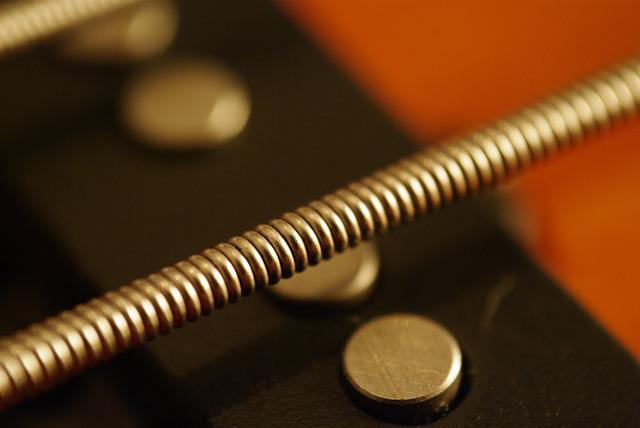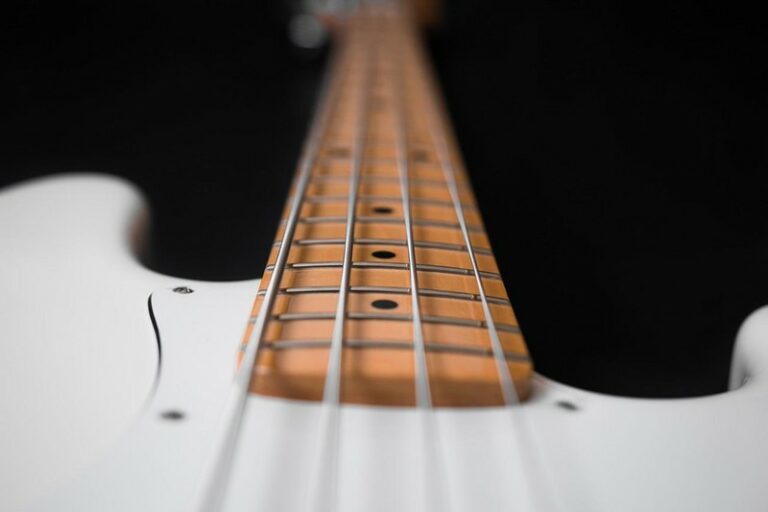Strings are one of the vital components of a bass guitar. And your choice of strings (for example, different string gauges and types) will directly impact how your bass guitar plays and sounds. The choice of strings for your bass will generally depend on:
- The specific tone you’re looking to produce.
- The music you play
- Comfort level you’re expecting
- The longevity you’re expecting out of the strings.
- Price you’re willing to pay
Picking the best strings for your guitar and your music style can be daunting for beginners as various bass guitar strings are available. This guide aims to help you choose the “best” string for you and your music style.
Bass String Name, Order & Tuning
There are various types of bass guitars available with a different number of strings and string arrangements. Most commercially available bass guitars have between four to six strings, and each string is given a number and a name.
The strings are numbered from the bottom up when you hold the guitar in the playing position. The names of the strings are usually the tuning they are in (in standard tuning). The top string has the lowest pitch and is the thickest, while the bottom string is the thinnest and produces the highest pitches.
The tuning and the name of the string on the three most popular commercially available guitars are as follows:
4-String Bass Guitar
The 4th or the top string, also called the E string, is the thickest and produces the lowest pitch, while the 1st is the thinnest. The strings are in the following tuning:
E (4)–A (3)–D (2)–G (1)
5-String Bass Guitar
5-String basses are called extended-range basses because they have an additional bass string B, which extends the lower range.
B (5)–E (4)–A (3)–D (2)–G (1)
6-String Bass Guitar
These guitars are also called extended-range bass and have two additional strings — bass string B and treble string C, extending both the upper and lower range.
B (6)–E (5)–A (4)–D (3)–G (2)–C (1)
Bass String Gauges (Thickness)
As noted above, the string’s gauge (or the thickness) and the tension give the bass guitar a lower pitch (the bass sound) compared to a regular guitar. Gauge means the thickness in diameter of the string measured in 1/1000th of an inch. A smaller number in gauge means a thinner string, while a larger gauge number would mean a thicker string.
Usually, the bass players reference the string gauge they are using by only their guitar’s thinnest string (G string). Similarly, some companies will only refer to the thinnest string in the pack, while many will state the gauge of all the strings. Other companies will use generalized naming like heavy, medium, or light for ease of choice for beginners.
The string’s thickness will directly impact the guitar’s playability and how it sounds. Heavier gauge strings will have more tension across and require greater finger strength to push down on the fretboard and strum. These strings produce a chunky, fatter sound, while the thinner strings sound brighter.
Therefore, the choice of string gauge would also depend on the genre of music, though, for beginners, it is advisable to start with light gauges. Most beginner basses also will come fitted with medium gauge strings.
Once you have got calluses from playing a medium or light gauge string, you can move on to thicker strings, especially if you’re in rock or metal music. One thing to note is that your guitar may need some neck adjustment depending on how significant the difference is in the thickness of the strings it originally came with and the one you wish to put on it.
Bass String Construction & Types

Bass guitar strings are composed of a core wire and a winding. While regular (non-bass) guitars have a mix of wound and plain strings in a set, all four strings in the bass are wound.
The core runs through the middle of the string and is fixed at the end with a brass cylinder commonly called the “ball end,” which attaches to the guitar’s bridge. The winding wire tightly wraps around the core and is what comes in contact with our fingers and fretboard.
Wound strings are able to produce a lower pitch than similarly thick plain strings, which is why they are used in bass guitars and the lower three or four strings of a standard guitar.
Core
The core of the bass strings is most commonly made of steel and is either hexagonal or round, cross-section-wise.
String with hexagonal cores (cross-sectional) are called hex-core strings and have a tighter winding that causes them not to slip easily off the core. Hex-core strings are more common and have better stability even in higher-tension tunings, preventing string breakage. Hex-core strings have a brighter tone compared to round-core strings.
Strings with round core wire are called round-core strings and were the traditional method of manufacturing strings. These used to be the typical choice for bass guitars until hex-core strings were designed. Round-core strings have a more significant contact (up to 100% theoretically) between the core and the winding and thus have a mellower tone. Although, winding slippage is a common issue with these strings.
Winding
In addition to the type and shape of the core, there are also several different methods of windings available.
Roundwound

These are the most straightforward winding style in which the strings have a round winding wire tightly wrapped around the core. These strings are easier to manufacture and are therefore cheaper.
The primary disadvantage to these strings is that owing to their uneven surface, there is increased friction between the strings and the fingers, especially when the guitarist slides over the string (required for certain types of songs). This friction causes an annoying squeaking sound which is more pronounced in the case of electric and bass guitars. These strings have a bright tone.
Flatwound

These strings have a squarer (cross-section) winding wire which makes for a flatter and even surface. Though they are typically used in fretless bass guitars, you can put them on any guitar.
Flat-wound strings have much less squeaking sound compared to round-wound ones. However, the downside to these strings is that they are much costlier and have a less bright sound compared to round-wound strings.
Halfwound

Halfwound strings have a mix of the above two styles of winding. These strings have a flat surface, much like the flat-wound strings but are less expensive.
The manufacturing process is similar to making round-wound strings though there is an additional step where the outer part is polished or ground to make a flatter surface, much like the flat-wound strings.
Since internally, the contact between the core and winding is the same as in round-wound, the brighter tone of the round-wound strings is still pretty much unchanged, while the flatter surface gives the benefits of the flat-wound types. These strings are generally more affordable than flat-wound and provide almost all physical advantages.
Materials Used
Electric bass guitars (the most common type of bass guitars) usually have a magnetic pickup. They, consequently, require that the string be made of ferromagnetic materials — usually steel, nickel, or a combination of the two.
Core Material
The material used for the core in almost all bass guitar strings is steel or alloys of steel, providing a robust foundation for the strings.
Winding Material
Stainless Steel
Strings wound with pure stainless steel have a bright tone and excellent durability.
Nickel-Plated Steel
Generally more expensive than the above, these strings give the player a better and smoother feel of the string along with a bright tone.
Pure Nickel
Though expensive, these strings are less ferromagnetic and have a warmer, more subdued tone than steel-based strings.
Coatings
Some strings have a preventive layer or coating to prevent the strings from corrosion over time. The most common coating material is nickel, but tin, silver, and even gold are used. Depending on the material used for coating, the strings may have a subtly different sound.
Another material used is Teflon, which is becoming more common nowadays due to its corrosion resistance and ability to make the string surface smoother.
String Gauge and Scale Length
In a bass guitar, the scale length is the distance between the nut and the bridge, consisting of the strings’ vibrating portion. For a guitar to be in tune, it requires the string to be under a specific tension which directly depends on the following two factors:
- The scale length
- The thickness or gauge of the strings
Any increase in string thickness or the scale length would increase the string’s tension in a particular tuning.
When to Change Your Bass Guitar Strings?
Guitar strings are under much more human contact, unlike other stringed instruments like the violin. Consequently, they are also much more exposed to chemicals in our sweat. Many of these chemicals are corrosive and deteriorate the strings over time, requiring a change of strings.
Many bass players change their strings when they start to sound “dead”; this is when the tone begins to lack depth and sounds muffled. Some people, particularly guitarists, change their strings far sooner to keep them always sounding bright since newer strings sound brighter than older ones.
Most beginner bass players would change their strings less often and usually only when the strings can no longer be played well. To prolong the life of the strings, it is a good idea to wipe them down with a cloth regularly (or even after each session) to help keep them clean. It is also advisable to wash your hands with soap and water before you start playing so that your hands are free from sweat.
Things To Remember When Choosing Bass Guitar Strings
- Choosing a string for your bass guitar depends on many factors, including the comfort level, music genre, price and the bass itself.
- As a beginner, you should try to get medium or even light string gauges to start playing.
- Different factors, like string thickness or gauge, materials used, etc., will impact your how guitar sounds.
- In most cases, beginner bass guitars come with medium gauge strings, which are well suited for beginner players.
- You can prolong your guitar strings’ life by keeping them clean.
- Some trial-and-error is inevitable. If you’re going for a different string than what you have, there is a possibility you might not like it. It’s part of the process — embrace it.
Final Thoughts
Choosing a bass guitar string requires researching the various choices you have in the market. Different strings have different properties regarding how they feel and sound. Therefore, the choice is critical, and I hope this article helps you make an informed purchase suitable for you.


